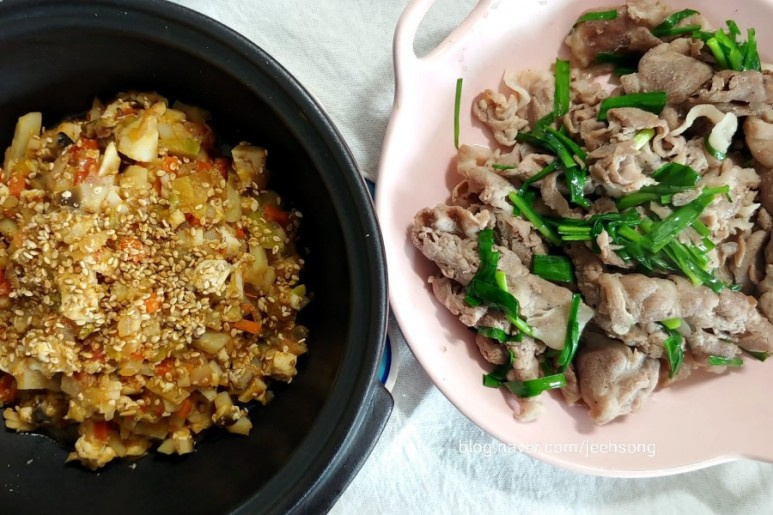Stir-fried Pork Belly with Chives and Low-Salt Vegetable Doenjang
Pantry Clean-Out & Low-Sodium Meal: Stir-fried Pork Belly with Chives and Hearty Low-Salt Doenjang (No-Water Added)

Experience the perfect harmony of flavorful pork belly and aromatic chives! Accompany this with a healthy, low-salt doenjang made from your fridge’s leftover vegetables. Cooked without added water, this dish highlights the natural flavors of the ingredients, enhanced by the umami and moisture from tomatoes. Served with fresh쌈 (ssam – wrap) vegetables, it creates a delicious and wholesome meal that’s both satisfying and nutritious. This recipe is a fantastic way to enjoy a healthy meal at home.
Vegetable Low-Salt Doenjang Ingredients- 1 eggplant
- 1/2 carrot
- 5-6 cloves garlic (minced)
- 1/2 onion
- 1/2 zucchini
- 1/2 pack oyster mushrooms
- 1/2 king oyster mushroom
- 1/2 Tbsp brown rice oil
- 1 tomato (small)
- 1.2 Tbsp doenjang (Korean soybean paste)
- Salt (to taste)
- Pepper (a pinch)
- 1 Tbsp cooking wine (e.g., Mirin, to remove meat odor, optional)
- Sesame oil (for finishing)
- Toasted sesame seeds (for finishing)
Stir-fried Pork Belly with Chives Ingredients- 500g thinly sliced pork belly or neck
- 1 bunch chives (about 50-70g)
- Salt (for seasoning)
- Pepper (for seasoning)
- 500g thinly sliced pork belly or neck
- 1 bunch chives (about 50-70g)
- Salt (for seasoning)
- Pepper (for seasoning)
Cooking Instructions
Step 1
First, prepare the vegetables for the doenjang. Use various vegetables you have in your refrigerator, such as eggplant, carrot, onion, zucchini, oyster mushrooms, and king oyster mushrooms. Dice all vegetables as finely as possible.

Step 2
Place the chopped vegetables (except for tofu and tomato) into a pot without any oil. Stir-fry over medium heat until the vegetables release their natural moisture and soften.

Step 3
Once the vegetables have softened, add 1/2 Tbsp of brown rice oil. Add the minced garlic and onion, and stir-fry until fragrant. (If you have onion, adding it here will enhance the flavor.)

Step 4
Now, add the diced tofu and tomato to the pot and stir-fry them together. Adding tomatoes provides enough moisture for a no-water cooking method and boosts the savory flavor.

Step 5
Cover the pot and let it simmer gently over low heat for about 5-10 minutes. The vegetables and tomatoes will soften and meld together.

Step 6
When the vegetables are tender, add 1.2 Tbsp of doenjang and stir well to combine. Be careful not to burn the doenjang by cooking over low heat.

Step 7
Cover again and simmer for another 5 minutes over low heat to allow the doenjang and vegetables to fully integrate. Adding 1 Tbsp of cooking wine (like Mirin) can help remove any pork odor.

Step 8
Once the doenjang is ready, transfer it to a pot or serving dish. Finish with a drizzle of sesame oil and a sprinkle of toasted sesame seeds for a nutty aroma. For extra flavor, you can also add perilla oil or ground perilla seeds.

Step 9
Now, let’s prepare the main dish: stir-fried pork belly with chives. Heat a pan, add the thinly sliced pork belly, and season lightly with salt, pepper, and cooking wine. Grill until golden brown. (Since you’ll be eating this with doenjang, season the pork very lightly.)

Step 10
When the pork belly is almost cooked, turn off the heat. Add the pre-cut chives and quickly toss them with the pork belly using the residual heat. This ensures the chives remain fresh and slightly crisp. Serve the finished stir-fried pork belly with chives alongside the homemade vegetable doenjang and fresh wrap vegetables for a delightful meal!



